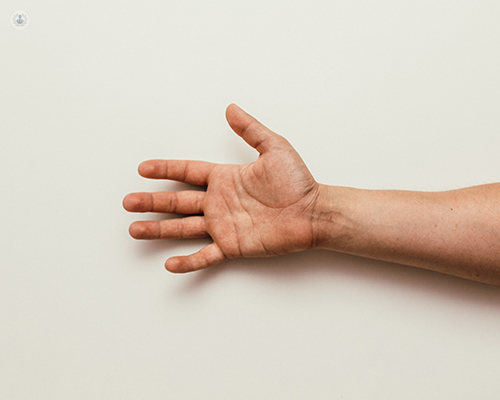Complex regional pain syndrome: an expert explains the condition
Autore:Complex regional pain syndrome (CRPS) is a condition that can pause severe pain in the limbs, among many other symptoms. In his latest article, leading pain management specialist Dr Anthony Ordman offers his expert insight into this condition, including the causes and treatments,

What is complex regional pain syndrome and how does it affect the body?
Complex regional pain syndrome (CRPS) is a painful illness that can cause extreme, unrelentless pain in patients.
It usually only affects one limb, such as the arm or lower leg, and it may be caused by trauma to that limb. Patients sometimes describe it as if the injury has healed, but the pain persists and is magnified in comparison to the initial injury.
Surgery can sometimes cause CRPS, and very rarely it can be caused by shingles, a strained joint, a heart attack or a stroke.
The term “Complex Regional Pain Syndrome (CRPS)” has replaced earlier terms like “Reflex Sympathetic Dystophy” (RSD) and Sudeck’s atrophy” in the medical community.
Today, CRPS is more frequently categorised as “acute” in the first 6 to 12 months of onset, and is later classified as chronic, and thus much more difficult to treat. Therefore, it is crucial to see a specialist as soon as possible to have the disease diagnosed and treated.
Although CRPS can strike at any age, it seems to become more common starting in early adulthood, and women are also more likely to be affected than males. It is not very prevalent, and we don’t fully get why some people experience it while others do not.
What causes complex regional pain syndrome?
Although the exact cause of CRPS is unknown, it is thought that a disruption in the central and peripheral nerve systems may result from a variety of factors.
Trauma or surgery, as well as the potential limb immobilisation that may accompany these occurrences, frequently trigger CRPS.
Inflammatory chemicals and neuropeptides are considered to be secreted from peripheral nerves in CRPS. During a process called central sensitisation, pain-sensing nerve fibres in the spinal cord are overstimulated, causing them to respond painfully to stimuli that would ordinarily be non-painful (such as light touch).
Neuropeptide release makes the blood in the tissues “leaky”, which results in tissue swelling, and vasodilation (the engorgement of blood vessels) results in changes in skin colour.
It’s interesting to note that CRPS has an impact on the brain as well. The somatotopic map, a type of map that exists in our brains and is located in the somatosensory cortex, is where our body parts are sensed. If an arm or leg were to be likened to a continent on a map, the continent corresponding to the affected limb shrinks in size in comparison to the continent size of the unaffected limb.

What are the symptoms of CRPS?
Pain is the CRPS symptom that affects people the most. This typically affects an arm or a leg and extends well beyond the site of the injury or procedure. It can occasionally spread to different body parts.
The pain is constant, and the limb may become sensitive to light touch (“allodynia”). When it comes to intensity of the pain, even a slight contact with the skin can be extremely uncomfortable. The skin may also develop a high sensitivity to cold.
In CRPS, skin changes often occur. The colour of the skin may alter, turning blotchy, red, white, or purple, and it frequently does so numerous times throughout the day. The temperature of the skin may also fluctuate throughout the day.
The skin may start to get exceedingly hot, tight, shiny and thin. Growth of the hair and nails may also be impacted. Typically, the limb swells and loses functionality. Sometimes there will be considerable sweating on the palm of the hand or the sole of the foot.
Often the arm or the leg will become stiffened and difficult to move, and the muscles may waste as function decreases.
The limb may feel “off” to the person with CPRS, movement may feel uncomfortable or jerky, and the limb's posture may change and become stuck.
As a result of their CRPS, patients frequently report experiencing anxiety or sadness. Some people may also report experiencing visual problems and "brain fog."
Additionally, CRPS can cause localized osteoporosis of the bone, decreased bone mineral density, and bony abnormalities in the finger joints.
How is CRPS diagnosed?
CRPS is diagnosed when a physical examination is performed, along with a thorough analysis of the patient’s medical history.
To rule out other disorders, blood tests or MRI scans may occasionally be necessary (such as autoimmune conditions or arthritis).
Early and correct identification of CRPS is crucial since earlier intervention improves treatment outcomes.
When diagnosing CRPS, physicians adhere to a set of standards known as the Budapest criteria.
These include examining the patient for signs of:
- Touch sensitivity,
- Changes in skin colour and temperature,
- Swelling and perspiration on the affected limb,
- Poor limb movement and function.
A specialized isotope scan occasionally aids in the diagnosis of CRPS.

Is there a cure for CRPS? How is it treated?
The most common CRPS treatments are physical therapy and occupational therapy. It is a journey to increase the mobility and function of the affected limb while equipping the patient with self-management techniques to deal with the symptoms.
It is crucial that the physiotherapist or occupational therapist completely comprehends the changes to the nerve system and brain caused by CRPS. They must always refrain from painfully manipulating the injured limb because doing so can exacerbate the problem.
The specialist physiotherapist will recognize that in CRPS, visual and manual exercises are needed to restore the nervous system's changes so that the connections between the brain and the affected limb can occur, allowing for the restoration of normal movement and the reduction of inflammation.
Gradual image therapy, a technique for retraining the brain's connections with the damaged limb, is frequently suggested by therapists. In order to lessen pain during and after treatment, consider using an acupuncture needle or TENS machine. Desensitisation training is a method to make the damaged limb's sensation to touch normal. The affected limb is frequently touched by the individual with various textiles (such as silk and wool), and as this is tolerated more, light pressure can be used.
As a pain doctor specialising in CRPS, I am extremely careful about which physiotherapist I choose to treat my patients, to make sure those colleagues possess these special skills and understandings.
Physiotherapy is also important, later on, to increase muscle strength and mobility. Hydrotherapy can also be very helpful.
Dr Anthony Ordman is a leading pain management specialist based in London, with over 25 years of experience in pain management medicine. If you would like to book a consultation with Dr Ordman, you can do so today via his Top Doctors profile.


